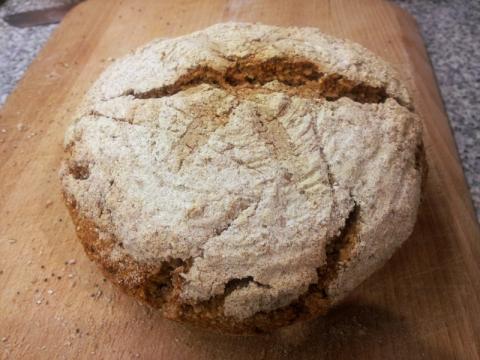
My Current Projects: Gluten Free / Bread for a "Treasure Island" fair

At the moment I am pursuing two totally different themes in my baking: Gluten Free bread and bread for a school summer fair themed "Treasure Island".
This blog post is intended as a journal for my thoughts and ideas, nothing is final yet.
The photo above is my take on "Pease Bread", the 18th century wheat-free alternative. See below.
Let's start with Gluten Free (GF) bread:
After my initial success with a Buckwheat-Millet Sourdough I am aiming to understand more indepth how GF flours behave. I will be using Psyllium husks as a gelling agent, avoiding all processed ingredients like gums etc.
My plan is:
- To determine the optimum amount of Psyllium needed for several GF flours. I will use a 60:40 flour:starch mix and instant yeast for these experiments. I will aim to adjust hydration in a way that makes the doughs feel similar.
- To determine the fermentability of the individual flours Plus Psyllium using Raisin Yeast Water, Rye Sourdough and Yeast.
- To develop a reliable GF Starter
- To work on flour combinations and taste
This is a lot of work, but i am really excited to do this.
My spreadsheet (work in progress) is here:
https://docs.google.com/spreadsheet/ccc?key=0AkcYHhPxccKtdG5aRV96RVY3TUkzdWM1R0tWcndmaXc&usp=sharing
/* UPDATE */
Posted some photos of step 1 above: http://www.thefreshloaf.com/node/33651/some-gf-experiments
/* ************ */
Having spoken to several people with food allergies it is clear to me that it might be necessary to design a bread for an individual person and their specific sensitivities.
A big Thank You to Gluten Free Gourmand and Laura T. for your inspirations:
http://www.thefreshloaf.com/node/32708/glutenfree-sourdough-progress
"Treasure Island" baking:
My son kindly volunteered me to have a bread stall at their school's summer fair.
This fair is meant to be organised by the children, and the theme is "Treasure Island".
It took me a few days to figure out what I could do within this frame of reference, and the pieces are starting to come together.
I looked into 18th century baking, and Andy (ananda) generously pointed me to an article about the history of flour usage in Britain.
I will have a group of children do most of the work on the day before the fair, using the school kitchen.
And this is what I intend to bake with them:
- Ships Biskets (Hardtack): the staple food of the sailors; this will be more for curiosity. Wholegrain Wheat flour 100%, Water 50%, Salt 2%, Mix until evenly hydrated, rest for 1 hour or so, shape flat palm-size biscuits 4oz each, dock, bake until completely dry, but not brown (I have to figure that one out). 4 of these was a sailor's daily ration.
- Pease Bread (see the picture at the top): The staple food of the very poor, or in times of bad wheat harvests.This is my take, quite tasty: Ground Haricot Beans: 30%, Ground Pearl Barley: 30%, Oatmeal 30%, Water 80%, Salt 2%, Rye Sour (100% HL) 20%. DT 28C. Bulk fermentation 2 hours, proof in basket 1 hour, long bake in falling oven.
- Maslin Bread: This would have been the staple bread of the lower classes in south England. My take on this: Wholegrain Rye: 50%, High Extraction Wheat: 50%, Water 75%, Salt 2% Rye Sour 20%. DT 28C. Bulk fermentation 2 hours, proof in basket 1 hour. Bake in falling oven starting hot.
- Manchet Bread: This is what the Squire, Doctor and Captain would have eaten. There are several historical recipes about, this is my first take. Everybody loved it: Stoneground White Strong flour: 100%, Water 54%, Salt 2%, Instant Yeast 0.7%. Mix, knead and beat the living daylights out of it with a rolling pin, until very silky. Get those carotenoids oxidized. They want WHITE bread! Proof 2 hours. Shape into batard. Proof 40 minutes. Bake at 210C.
I will try out some other recipes for Manchet, and I intend to use ale barm - this afternoon I will pick up some from the brewery.
Here is a picture of Manchet and Maslin breads:

And here is a crumb shot of Maslin, Manchet and Pease Breads:

I am off to my kitchen now...
Cheers,
Juergen


Comments
baking and resulting bread. Seems gluten free is catching on everywhere. I know that sweetbird is baking that way now too. Bill O'Reilly credits his wonderful health and complete old age turnaround on his no gluten diet - who knows, maybe Bloomberg will ban gluten in NYC too and save them from sure death, like he did for cigs, stogies, sugar, duck liver, fat and salt. Got to get into some gluten free baking of some kind.....
Thankyou, dabrownman.
Gluten free baking is a very different experience. I am now confident that really tasty GF bread with a nice texture is possible.
I have been over to the brewery this afternoon (Harvey's in Lewes, UK), got some ale barm and a couple of bottles of their nice produce.
I made a "Manchet" dough using the barm, baked some and reserved some as "old dough".
The kitchen smelt incredible: the scent of baking bread mixed with the aroma of hops and malts that are present in the barm.
I look very much forward to cutting into that bread. Pictures will be posted soon.
optimizing all of those formulas! It looks like the pease bread crumbles the most.
Have fun.
Yes, there is nothing in it to hold it together.Oats and beans and barley ... But I think this is very much a feature of that bread.
Baked without the sour it is "Horse Bread" - Horse food.
Here is a link to a document about somewhat more refined horse feed:
http://www.williamrubel.com/wp-content/uploads/Rubel_Gatronomica_Horse-bread.pdf
Enjoy,
Juergen
I wonder if your son expected such authenticity. Quite a project you undertook. Really cool. All I can say is
pease porridge hot
pease porridge cold
pease porridge in a pot
five days old
Oops sorry. I guess that's the only other place I've seen the word pease.
Very interesting. Kind of scary. I want to try that pease bread but ...
-Varda
what can get you worried now?
There are some formulas around using gram flour (Arkatena Bread from Bread Matters, for example).
I didn't quite know what to expect from a bread containing only beans, barley and oats, except that it would be dense and crumbly.
Just had a little bit of it, still quite tasty. It seems to keep very well.
I am not sure Benjamin expects authenticity, but the more I think about this project the more it makes sense: Putting bread into its social context creates a lot of hooks to discuss things ranging from breadmaking techniques to nutrition.
We'll have a tour of a brewery and collect the yeast.
We will make a yeast preferment a nd rye sourdough.
We will make a highly kneaded low-hydration white bread and a medium hydration wheart/rye sourdough.
We will make the seemingly impossible Pease Bread.
We will make Ships Biscuits and possibly use them to make Plum Duff (a favourite sailors' pudding).
I am getting all excited...
Very interesting projects you have undertaken Juergen. I wish you luck on your gluten free experiments. I know many people who will be very happy to read and try your results.
Your kids project looks like you had a lot of fun developing. The breads look and sound great. Those biscuits though sound like they would have made good cannon ammunition :).
Thanks for sharing your experiences with us.
Ian
and really are getting me excited!
Thank you,
Juergen
Hard tack is very much alive and well in Newfoundland - I grew up munching on it as a kid and I'm under 40! We still have brewis made from it every year as our traditional Christmas breakfast.
Soak the hard tack in a large bowl of water overnight, covered with a plate to keep the biscuits submerged. Allow one per person.
In the morning fry up a pan of bacon. Remove the bacon to a plate to drain. Wring most water out of the soaked biscuits by hand, and fry the crumbled biscuits in the bacon fat. Season with salt and pepper to taste. Return the bacon, crumbled into large bits to the pan towards end of cooking. Cook until brewis is dried out and a little crispy.
Traditional recipes have soaked dried salt cod cooked and added to this too, and use cubed port fat instead of bacon (called scrunchions). There are recipes for boiled brewis but that's just tasteless mush, IMO. The fried version is by no means healthy (hence only once a year) but yummy!
using Ships Biskets!
You will feature on the handout that will go with them.
Thank you so much!
Juergen
hehe, "beat the living daylights of the dough"! you made my day, Juergen!
Yeah, there is a recipe in Richard bertinet's book, Crust, for Manchet bread, though it goes by another name.
I'm enjoying your 18th century bread experiments very much. The pease bread is interesting. Never thought about baking non-gluten breads. Were do you get the psyllium husk from, and what is the price per kg?
Thanks in advance,
-Khalid
I've never tried that recipe, but it acts a little bit as a guide in terms of the process.
Yesterday I made a Manchet with real Ale Yeast. Very tasty.
I'll post pictures soon.
About the GF ingredients: We have a company here in the UK called "Neil's Yard", and they have a huge variety of homeopathic medicines and herbs, many of their staff are trained herbalists.
I got 100g and paid aboud GBP 2.50 (can't remember exactly). Strange material - it takes about 20 times its weight of water. I'll post pictures of some GF experiments soon.
Thank you for your interest.
Juergen
and a real challenge. I like the idea of the historic breads, and will be tempted to try one of those.
But don't forget to add back the sand and little stones to the flour that modern milling processes remove from the grains - they provide you with the right historic bread chewing experience :)
Karin
no shortage of all sorts of little stones ....
But the ships biskets will be enough of a challenge I fear.
Thank you,
Juergen
Hi Juergen,
Have you come across the Golspie Mill? It's in Sutherland. They mill pease meal and bere meal [old type of barley]. It's featured in Dan Lepard's Handmade Loaf. I visited it years ago with a good friend when I was living in Ullapool for a while.
Great project, thanks for the mention
All good wishes
Andy
for the hint about the mill. I was wondering how to mill all my stuff (here I use a hand-crank mill with 150g capacity)
I'll try and complete the schedules for the whole school thing this weekend, Then the real work begins.
The pease bread I baked last Monday only gets better. Interesting.
Best Eishes,
Juergen
Juergen
I tried to make1. Russian Rye, Bread Matters Version .I followed your instructions to the letter. The bread continues to turn out too dense. Does altitude play a factor? I am at 5,280 feet in Colorado. How to make this bread more fluffy, lighter, less dense as seen in your pictures? Do I need to Knead this dough?
Richard H.
Hi Richard, do you have photos, ideally of the starter and the crumb?
I don't believe it's the height, more likely dough temperature and handling.
Thanks,
Juergen